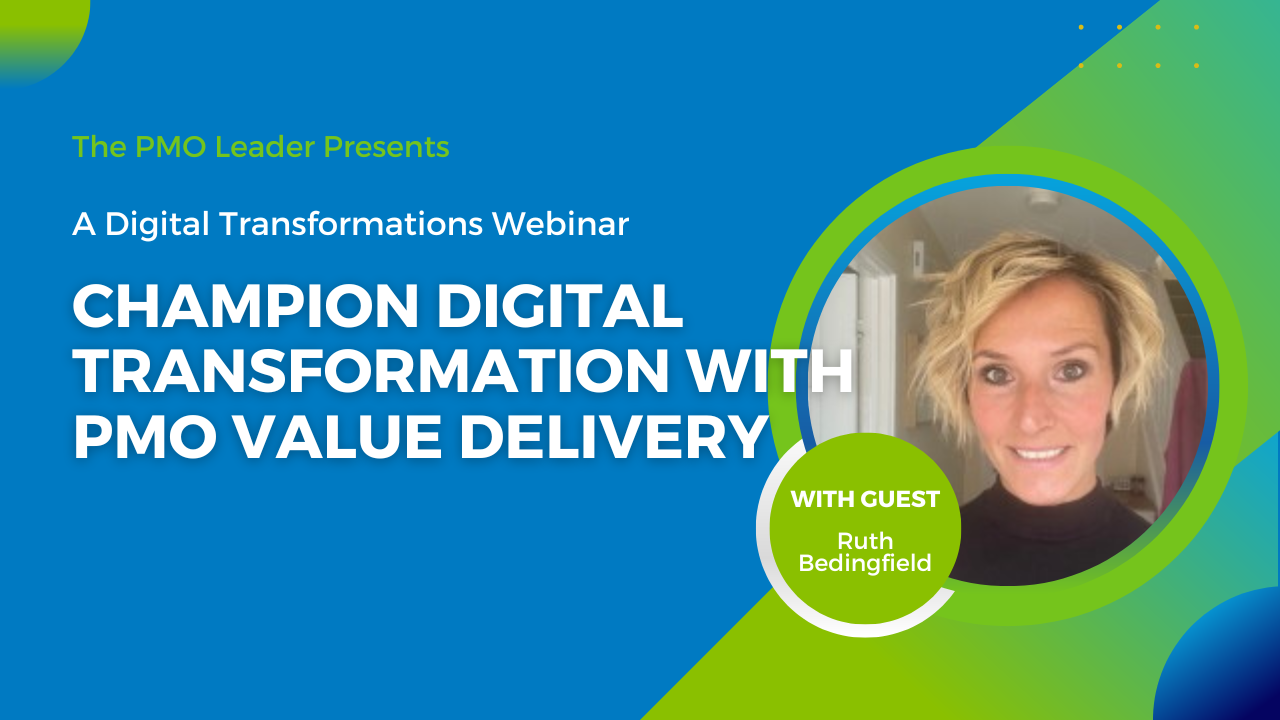
How to ensure your PMO brings value to stakeholders engaged in digital transformation
By: Rachel Hentges
In the most recent webinar of The PMO Leader’s Digital Transformation Webinar Series, Ruth Bedingfield from KeyedIn explained how ensure your PMO remains a champion throughout digital transformation. Here’s what I took away from the live webinar.
Digital transformation can be a lot of things and it’s a big topic right now for almost any organization looking to grow and innovate. For some, digital transformation is the adoption of technology to create new ways of working and for others it’s keeping up with changing business needs by increasing productivity and efficiency or modifying the existing landscape through value driven innovation. But, why are organizations doing this?
Digital transformation often reflects greater strategy shifts for an organization. One reason is long term survival. Organizations have identified that the status quo won’t cut it for success tomorrow and things must change in order to ensure longevity of the business. Another reason organizations are embracing digital transformation is cost reductions. This often is a result of trying to become more lean and agile in their execution but continuing to deliver. Growth is another catalyst for digital transformation. Organizations understand that growth is required for greater success and digital transformation can aid in organizational growth goals. Delivering greater value to customers is another reasons organizations are embracing digital transformation to continue to provide their customers with the value they expect. Lastly, digital transformation enables adaptability and organizations know that being able to adapt to the changing business environment that we are bound to encounter is crucial to business success.
Knowing why your organization is undergoing digital transformation is important when determining how to position your PMO for success.
Here are the 4 pillars to position your PMO for success in digital transformation:
- Act as the supporting strategic arm: As the strategic arm and backbone of an organization, the PMO plays a critical role in achieving an organization's strategic goals by ensuring that the right tools, processes, and cultures are in place to meet requirements for project success. Traditionally, this entails extensive reporting standards and excessive processes that earned the PMO its unfavorable nickname as the ‘project police’. Traditional PMOs have become well known for excessive over documentation that not only adds unnecessary work to teams but also makes any new change implementation potentially a slow and arduous process. This has to change for a PMO that will succeed in digital transformation.
- Provide consistent and continual support with data: Having key, consistent, data allows you to remove the emotion out of action taking and decision making. Full transparency establishes the PMO as the trusted advisor – when you report the good and bad, you are driving trust. Leadership will see that there is nothing being hidden. You are giving them the full data picture to be able to review and act upon. It also supports the data journey to provide the data executives need for strategic insight-led decisions making.
- Share successes – big and small: One thing we don’t do enough is celebrate the successes, regardless of size. We focus on what is not going so right, rightly so as this requires action, however the balance to this is publishing when things have gone well, when change has been delivered. It reminds people that their hard work is valued, and no matter the size of success it all adds into the overall organizations’ success.
- Enable successful digital adoption: Introducing new technology often involves including new teams and building new skills to make sure the adoption process is as smooth as possible. As the central hub of truth, PMOs are able to see the big picture impact of digital transformation initiatives, manage potential bottlenecks or pressure points and optimize their ongoing processes to make sure digital transformation initiatives are successful. Managing digital transformation involves making sure that all the necessary resources, skills, feedback systems, and data collection practices are in place and calling out early when there could be bumps in the road.
What does this look like in reality?
From Ruth’s experience, she navigated from what she likes to call “architectural spaghetti” to a smarter, single stack. What is architectural spaghetti you may ask? It was a home grown technology that the organization had. It was over engineered, over complex and it was over customized and didn’t lend well to the adaptability and innovation that the organization knew it had to have to be successful tomorrow and beyond. The digital transformation the organization underwent provided a simple yet powerful solution. It enabled organizational alignment that allowed visibility into a true vision for the future.
Another example shared focused on the importance of “The PMO Pivot”. A global retailer that Ruth supports as part of her customer success role at KeyedIn recently and successfully moved from a Portfolio Management Office to an Agile Portfolio Office. The organization had to review their hierarchies of data flow, restructure delivery teams to align better to key initiatives and technologies whilst maintaining a balance of financial reporting and Capex/Opex management. The teams are still on the digital transformation journey but have a great foundation to successfully measure and deliver value.
So, how can you do the same thing?
Here are your next steps to ensure PMO value through digital transformation:
- Understand key success objectives
- Align your PMO to those key success metrics
- Report consistently and transparently
- Prepare to pivot and flex and consistently communication up, down and laterally
- Continually review and iterate
The key for the PMO is to become a trusted advisor for the organization with open communication, strategic alignment and the ability to embrace The PMO Pivot.
